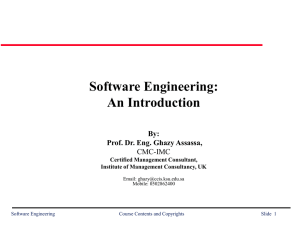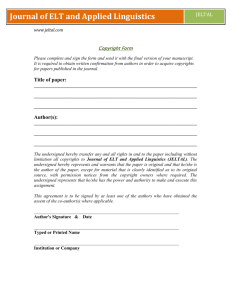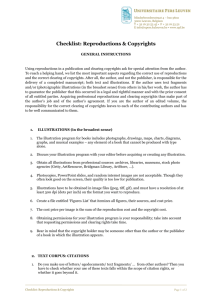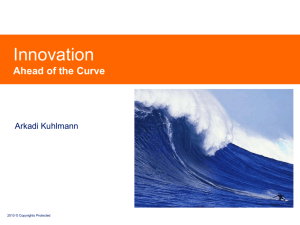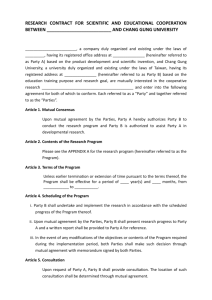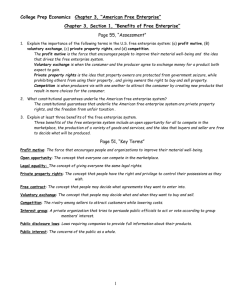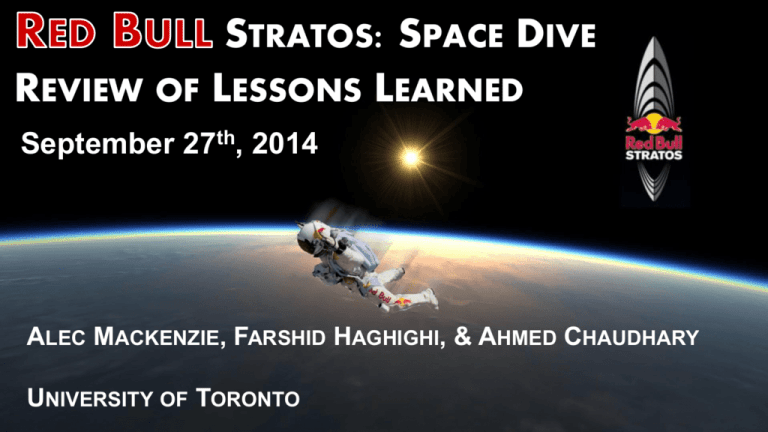
STRATOS: SPACE DIVE
REVIEW OF LESSONS LEARNED
September 27th, 2014
ALEC MACKENZIE, FARSHID HAGHIGHI, & AHMED CHAUDHARY
UNIVERSITY OF TORONTO
Copyrights Reserved
Copyright © 2014 by Ahmed Chaudhary, Alec Mackenzie, Farshid Haghighi
All rights reserved. No part of this publication may be reproduced, distributed, or transmitted in any
form or by any means, including photocopying, recording, or other electronic or mechanical
methods, without the prior written permission of the publisher, except in the case of brief quotations
embodied in critical reviews and certain other noncommercial uses permitted by copyright law. For
permission requests, write to the publisher, addressed “Attention: Permissions RedBull Stratos
Presentation,” at the email addresses below.
ahmed.chaudhary@mail.utoronto.ca
alec.mackenzie@mail.utoronto.ca
farshid.haghighi@mail.utoronto.ca
Copyrights Reserved
Agenda
❖
❖
❖
❖
❖
❖
Project Background
Company Overview
Project Timeline
Lessons Learned
Conclusion
Q&A
Copyrights Reserved
Project Background
● October 14, 2012: Felix Baumgartner jumped from 39 km
● Previous record set in 1960 by Joseph Kittinger (31 km)
● Stratos Space Jump sponsored by Red Bull
● Initial Estimate 3 Years and $6 Million (USD)
● Project team included 20 engineers and scientists
Copyrights Reserved
Red Bull Company Overview
●
Found by Dietrich Mateschitz in the mid 1980‘s.
●
Over 40% market share in the global energy drink market
(estimated 5 billion cans were sold in 2012)
●
Known for a “Renegade” Marketing Strategy:
●
Red Bull Formula 1 Race Team
●
Red Bull Ice Crash
Copyrights Reserved
Project Timeline
Copyrights Reserved
Project Team Organization
Project
Sponsor
Red Bull
Second
Technical
Director
Patrick Wright
Flight
Operations
and Safety
Colonel Joe Kittinger
Technical
Project
Director
Art Thompson
Medical
Doctor
Jonathan Clark
Red Bull
Stratos Pilot
Felix Baumgartner
Life-Support
Engineer
Mike Todd
Program
Manager &
Senior Flight Test
Engineer
Marle Hewett
Copyrights Reserved
Skydiving
Consultant
Luke Aikins
High
Performance
Director
Andy Walshe
Copyrights Reserved
Time/Cost Management (1/2)
Lesson Learned #1: “Conservative estimates for budget and schedule should have been established”
●
●
Situation:
●
The baseline estimates for budget and schedule were very
inaccurate.
●
Lack of precedent of similar projects
○
Unique Scope & Complex project.
○
Last successful similar project attempted in 1960
(Technology and Accepted Risk)
○
Technology has changed since 1960’s
Control Actions:
●
●
Involve SME’s more during various phases of the project to
prepare a better project management plan, WBS, schedule and
budget.
Follow PM techniques such as scheduling and cost control
Copyrights Reserved
A meeting at Sage Cheshire Aerospace Center
Time/Cost Management (2/3)
Lesson Learned #2: “Better PM practices could be used for cost control and
schedule management.”
●
Situation:
●
Project involved complex engineering tasks of building a capsule, a suit and a
balloon.
●
Primary technical manager used whiteboard and drawings to plan the project.
○
●
No indication of PM techniques and software being used
Corrective Actions:
●
Implement PM techniques such as Cost Control and Scheduling
●
Focus on estimating activity durations
Copyrights Reserved
Time/Cost Management (3/3)
Lessons Learned #3 “Implement critical path scheduling.”
● Situation: Project executed in linear mode when many tasks could have
been carried out in parallel.
o Training of pilot delayed technical aspects of the project (i.e. pressure
suit and capsule testing)
o Crashing training schedule resulted in potential safety concerns
● Corrective Actions:
o Implement PM processes during planning/initiation (i.e. baseline
schedule) and identify critical path
Copyrights Reserved
Scope Management
Lessons Learned #4: “Clearly define scope and provide an adequate level
of detail in the WBS.”
● Problem Situation: Overlooked tasks revealed during project execution
o Lack of detail in WBS – large work packages (i.e. pressure suit)
o Lack of deliverables to track project status
● Corrective Actions:
o Follow proper PM processes during planning/initiation (i.e. PM Plan)
o Organization require sponsor/management approval of PM Plan
Copyrights Reserved
Risk Management (1/4)
Lessons Learned #5: “Instead of focusing only on technical risks,
comprehensive risk management should be conducted”
Cause
Risk Event
Effect on Project
Working condition and
environment
Loosing a team member
Overspending and delay in
the project, Not being able to
complete the project
Telecommunication issues
Missing radio connection
Delay in the project
Weather conditions
Loosing a balloon
Delay in the launch date
Temperature differences
Condensation and misting
Safety, Aborting the project
Risk Identification Statement
Copyrights Reserved
Risk Management (2/4)
o Poor radio connection
•
1 hour delay in the capsule’s launch
o Rising winds
•
Losing one balloon as well as the pilot’s confidence
Copyrights Reserved
Risk Management (3/4)
● Situation:
o What to do in case of losing one of your experts?
o Felix leave the team for one year
o Some engineers leave their job for 6 weeks
Copyrights Reserved
Risk Management (4/4)
● Corrective Actions:
o Systematic and comprehensive risk analysis to consider every task
o Minimize loss of project knowledge and delay by creating a backup
plan for key people and better documentation
o Engaging the entire team in risk assessment for identifying worst case
scenarios
Copyrights Reserved
Human Resources Management (1/2)
Lesson Learned #6: “Ensure projectized team members align with
Organization’s strategic goals.”
●
●
Situation:
o
Isolated projectized organizational structure
o
Minimal job security for project team
o
Ingrained in work practices
o
New PM lacked authority and technical experience
Corrective Actions:
o
Increased Management/Sponsor involvement in planning/initiation
o
Implement strong-matrix organizational structure
Copyrights Reserved
Human Resources Management (2/2)
Lessons Learned #7: “In selecting team members, competencies needed
were overlooked.”
●
●
Situation:
●
Selection of Felix as the jumper posed risks to project schedule and safety
●
Selection of Art Thompson to serve both as the project manager and the
technical manager caused the quality of project delivery to be degraded
Resolution:
●
Redbull could have been more proactive in handling Felix in a professional
manner
●
By implementing a strong-matrix organization structure, they could have
separated the roles of technical manager and project manager
Copyrights Reserved
Stakeholders Management
Lesson Learned #8: “Knowing your stakeholders properly to avoid further
costs and consequences”
● Situation:
o PM not paying enough attention to stakeholder’s interests,
involvement, expectations, importance, influence, and impact
•
Internal Stakeholders such as Red Bull and Team members
•
External Stakeholders such as Press and World’s Media
● Corrective Actions:
o Use tools such as P/I grids to Identify all the stakeholders and
communicate throughout to build trust and find about their concerns
Copyrights Reserved
Quality Management
Lessons Learned #9: “When Health and Safety is a major concern, a high
level of quality is required for successful implementation.”
● Situation:
o Major design work packages related to H&S concerns:
Flat spin, Sound barrier, Fluid vaporization (Armstrong Line)
o Culture of acceptable risk has changed since 1960
● Corrective Actions:
o Adjust budget and schedule to achieve quality(safety) requirements
o Project team “buy-in” to quality/attention to detail
o Management “buy-in” to quality and safety
Copyrights Reserved
Conclusions (1/2)
● Although behind-the-scenes there were some drawbacks such as:
●
Delays in schedule (4 years)
●
Major cost overruns $6m to $30m
●
Unforeseen safety concerns and risks
●
Replacement of Project Manager 1 year into the Project
●
Felix Baumgartner quit the project for 1 year
Copyrights Reserved
Conclusions (2/2)
● However from a technical aspect the Project accomplished many
unique :
●
●
●
●
●
Felix successfully jumped from 39 km above earth
Felix successfully broke the sound barrier
8 million people watched the jump online alone. 40 TV channels
broadcasted the jump live across 50 countries.
RedBull estimated at $9bn, $25m budget overrun minimal impact
Space dive remembered as a momentous feat of human endurance
and willingness to push boundaries.
Copyrights Reserved
References
• Media:
o Space Dive, A Documentary on the RedBull Stratos Space Dive, BBC Films Inc.
• Technical Reports:
o RedBull Stratos Scientific Summit 2013: Summary Report, by RedBull Stratos Team
• Websites:
o www.redbullstratos.com
o http://www.arraspeople.co.uk/camel-blog/projectmanagement/space-dive-successful-projector-glorious-failure/
Copyrights Reserved
Questions & Answers
Thank you for attending our presentation
Copyrights Reserved

